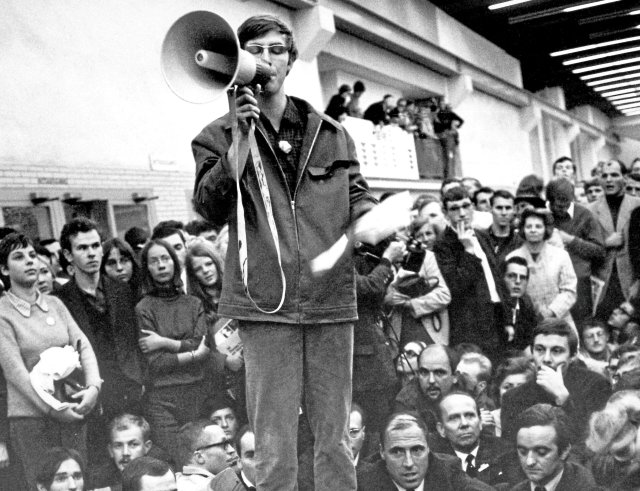Men say what should be done: The practice of the student movement around 1968 definitely needed critical and theoretical reflection.
Photo: akg
The book launch begins 20 minutes late in the now overcrowded Café KoZ on the former Bockenheim campus of the university in Frankfurt am Main. 100 people came to attend the launch of Alex Demirović’s book “The Nonconformist Intellectual,” which, as he says, “took him twelve years of my life.” Stephan Lessenich, director of the Institute for Social Research (IfS), and Christina Engelmann, who worked on a current study on feminist perspectives on the history of the IfS, discuss the newly published study on the renewal of Marxist thought through critical theory in post-war Germany.
Education of youth
The student house in which the book launch took place was personally opened 71 years ago by Max Horkheimer, then rector of Frankfurt University, and, together with the aforementioned Café KoZ, was placed under student self-administration. As he said in the opening speech in 1953, it seemed to him “not only like the realization of a dream, but also like a promise that an even bolder one would come true.” He also referred to the general plight of students at that time – most of the university’s buildings were destroyed and students had to help rebuild them. The student house was intended to be the place for the “development of productive imagination”. Horkheimer predicted: “The effect of this cell will extend to the entire university and continue to do so; it will become its center.” As Demirović points out in his study of older critical theory, the student house should contribute to the democratization and education of academic youth far beyond science.
nd.DieWoche – our weekly newsletter

With our weekly newsletter nd.DieWoche look at the most important topics of the week and read them Highlights our Saturday edition on Friday. Get your free subscription here.
Horkheimer’s speech practice was therefore a “specific discursive intervention,” explained Demirović, whose special profile he highlighted in contrast to other university speeches of the time. In these speeches by Horkheimer and Theodor W. Adorno, the theoretical pillars of critical theory became clear: students should “not go hiking and fall victim to the blaring of the radio, which makes people stupid,” but rather an appeal was made to an active student body that “has a… practices truth-oriented living and aims at the rational transformation of contemporary society and its everyday practices.”
Whistling through the Institut
Adorno and Horkheimer’s concern for offspring was great at the beginning of their return from American exile. The greatest fear that the students were German nationalist or National Socialist soon turned out to be unfounded – even if, as Demirović explained, “most of the lecturers were real Nazis.” In addition, Horkheimer and Adorno were seen by the university management as “rich Marxist Jews”. Nobody knew about her theoretical work when she returned.
Demirović tried to make it clear in his study and on this evening why Horkheimer and Adorno, who were aware of all this, decided to return in this post-war situation characterized by anti-Semitic and racist continuities. The extensive study was created, as he said, “in detailed archival work – in the spirit of Michel Foucault.” At the beginning of his work, Demirović could not do much with critical theory and the view of it shaped by Habermas and others. He himself felt more committed to post-structuralism.
According to Demirović, the image in the 1990s was of Adorno being resigned. That this was not the case “was also conveyed to me by Adorno’s long-time secretary, Ms. Olbrich,” he explains. »She was a trained radio announcer and could imitate German dialects wonderfully. She and others painted a picture of a happy Adorno who ran through the IfS whistling. Last but not least, letters also show that Horkheimer and Adorno saw the return as an opportunity for theoretical and intellectual creativity.
Interpretation conflict
Demirović’s stories about the intellectual and theoretical practice of Adorno and Horkheimer culminated in the chapter that was at the center of his book presentation: “The interpretative conflict surrounding theory and practice.” Demirović described how the Socialist German Student Union (SDS) was expelled from the SPD, moved its headquarters to Frankfurt and what effects this had. “Through personnel overlaps, SDS members who studied with Adorno and at the IfS, but also through contingent events, Critical Theory, the SDS and the New Left formed a symbolic connection.” Demirović did not come that evening to the break between political practice and critical theory, which finally became apparent on January 31, 1969 in the occupation and evacuation of the IfS. “I’ve already talked way too much anyway,” he said and handed the microphone back to the moderator.
In his study, Demirović closes the theory-practice chapter with the fact that Adorno himself “intervened practically with the texts and set processes of maturity in motion.” “Unlike political action, Adorno obviously understands theory as something casually general and aimed at humanity as a subject.” Finally, he quoted Adorno as saying: “He who thinks is not angry in all criticism.” But in the concrete conflicts of the 1960s different and divergent uses of critical theory are articulated. As Demirović points out, Adorno – shortly before his death on August 6, 1969 – at least indicated that he wanted to respond theoretically.
Infamous Tomatenwurf
Following the interviews that were conducted as part of a current research project on feminist perspectives on the history of the IfS, Christina Engelmann asked whether the autonomous women’s movement could be seen as a theory-practice counter-model to critical theory and SDS practice. She referred to the criticism of Elisabeth Lenk, who gave a keynote speech on the re-foundation of the SDS in 1962: “According to Lenk, the nonconformist whistles at the world, but what he whistles is its melody.” Engelmann concluded that his own position was also being radically questioned must be.
Adorno’s criticism of the student movement was, among other things, that the members had “used critical theory instrumentally” “in order to confirm their own practice,” as Engelmann summarized. The Action Council for the Liberation of Women criticized the male dominance within the SDS and so, at a delegates’ conference in 1968, there was the famous throwing of tomatoes at Hans-Jürgen Krahl – one of the SDS’s spokesmen alongside Rudi Dutschke.
This reflection of one’s own positions in the social power relations was already part of the autonomous women’s movement of the 1970s. By founding women’s centers, women’s bookstores and clubs, spaces were created “in which women articulated experiences that had not previously been visible in this way.” The crucial thing, Engelmann said emphatically, was “that these experiences then influenced further research to explore the overall social connections behind these experiences.”
Anderson versus Demirović
The current head of the IfS, Stephan Lessenich, also had his say at the end. He praised Demirović’s work, which he saw as a counter-book to Perry Anderson’s famous essay “On Western Marxism” from 1976. Anderson had sharply criticized critical theory and, above all, complained that academization led to a break with political practice. The essay was only published in a new edition in 2023, to which Lessenich contributed an afterword. The new edition has now been withdrawn from sale because Anderson did not authorize the afterword. “It is not known whether this happened because of my afterword or whether Anderson generally rejected one,” says Lessenich humorously.
“Adorno may have been skeptical about politics, but not about practice,” Lessenich confirmed Demirović’s comments. He emphatically encouraged those present to read the newly published study. “If you don’t have that much time, then you should at least read the chapter about the conflict of interpretation between theory and practice.”
Alex Demirović: The nonconformist intellectual. From critical theory to the Frankfurt School. Almond tree, 800 p., br., 38 €.
#ndstays – Get active and order a promotional package
Regardless of whether it is pubs, cafés, festivals or other meeting places – we want to become more visible and reach everyone who values independent journalism with an attitude. We have put together a campaign package with stickers, flyers, posters and buttons that you can use to get active and support your newspaper.
To the promotional package
